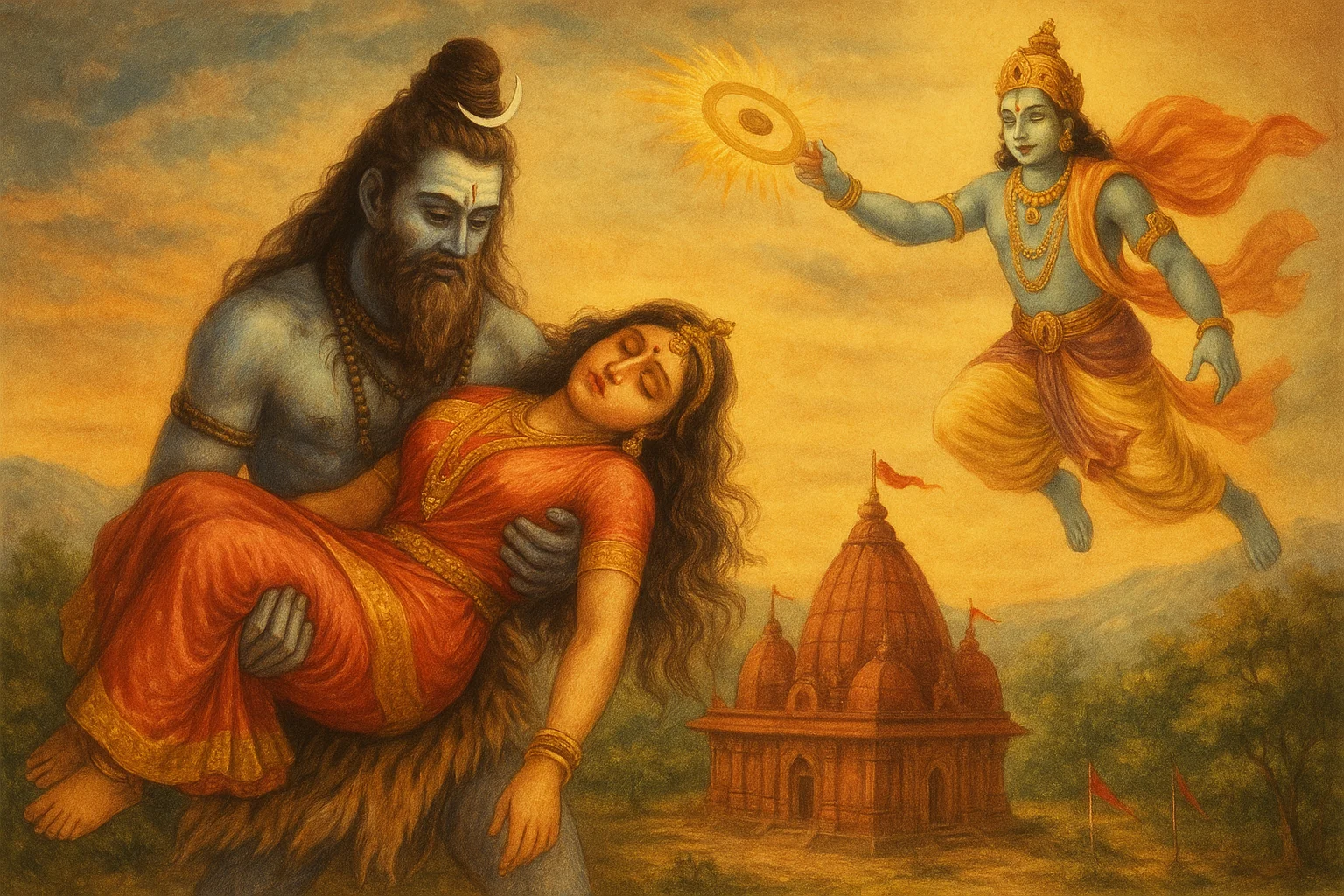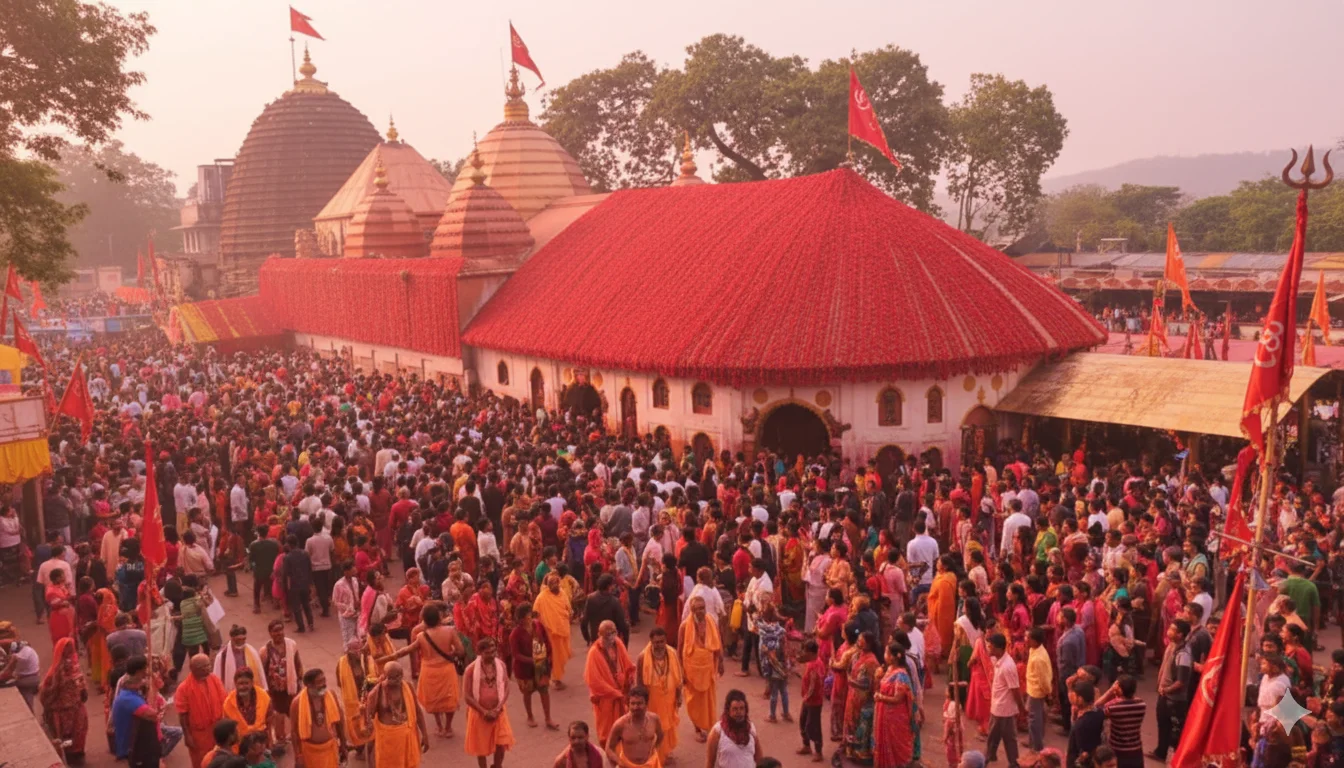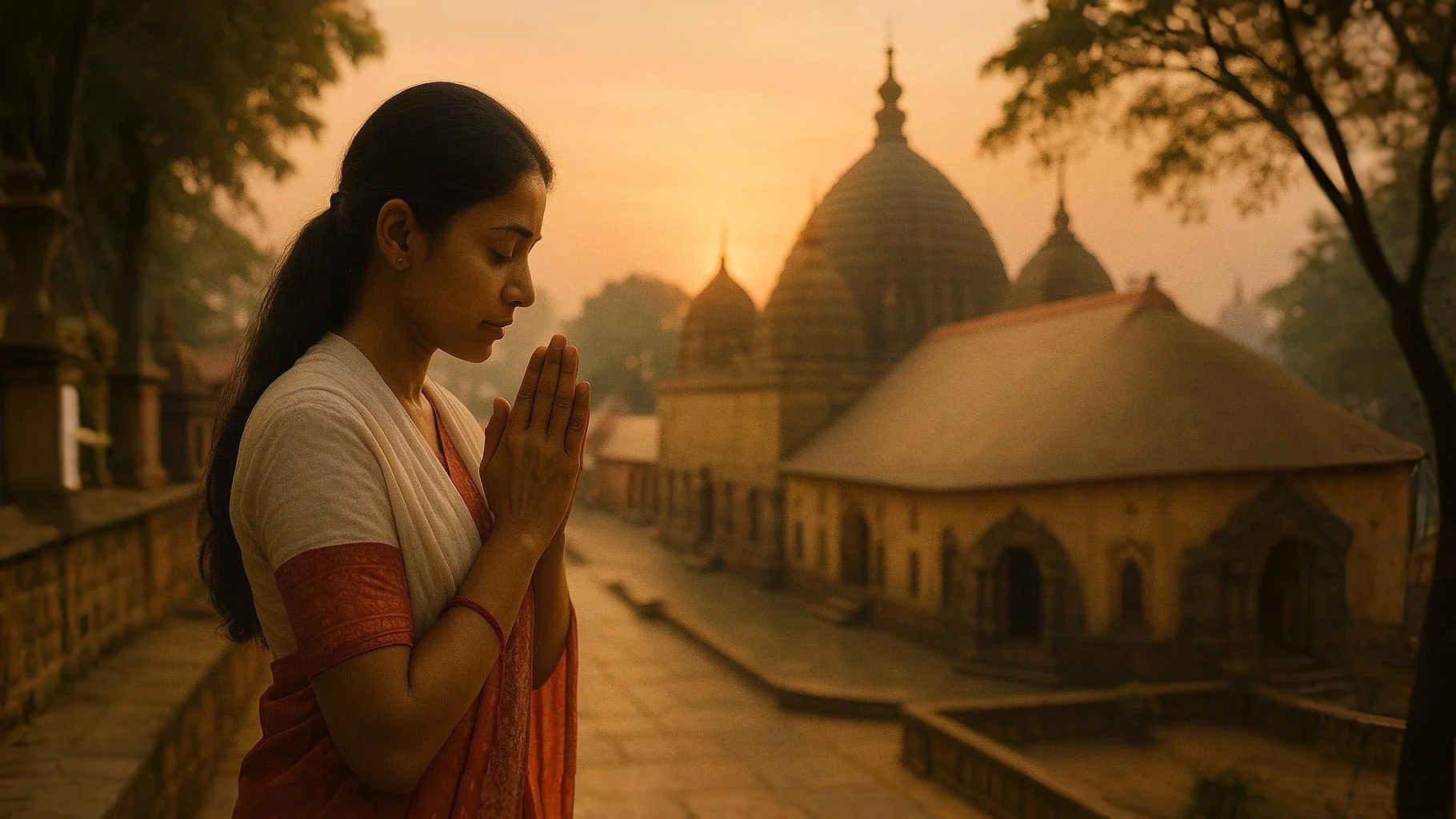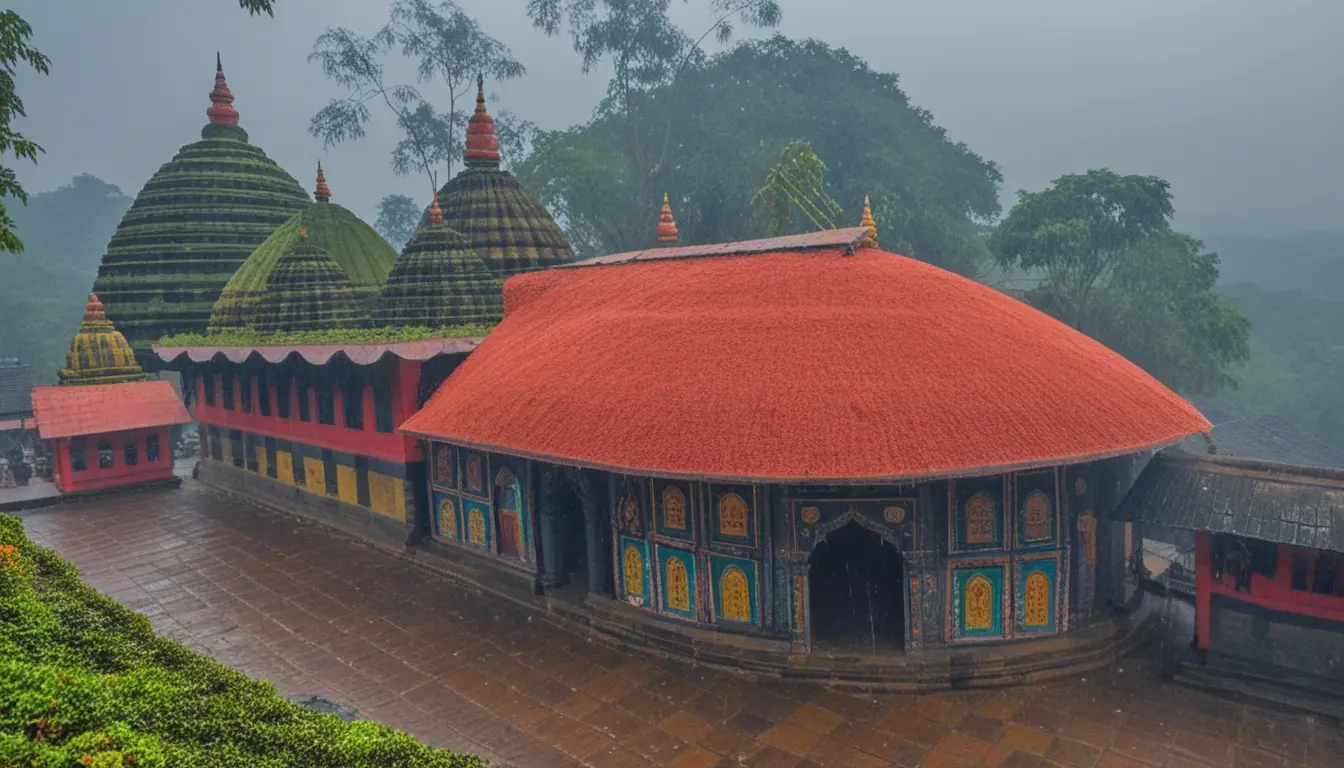
When the Goddess Rests: Understanding the Sacred Logic Behind the Kamakhya Temple’s Menstrual Mystery
This article addresses Kamakhya Temple menstruation — why the Ambubachi Mela venerates the Goddess’s cycle and why women are restricted from the inner sanctum.
In the temple of Kamakhya, menstruation is celebrated as a sacred event. The temple is situated on Nilachal Hill in Assam and is known as the shrine of the “Bleeding Goddess.” Even though at Kamakhya Temple menstruation is honored during Ambubachi Mela, women are traditionally prohibited from entering its inner sanctum while on their cycle. Is this not a contradiction? To comprehend Kamakhya, one must step into a world where biology and divinity are fused with cosmic energy to disclose an ultimate reality about protection, power, and the sacred rhythm of femininity.
Table of Contents
The Heart of the Kamakhya Paradox: Celebration vs Restriction
In the Nilachal Hills of Guwahati, Assam, which are covered with lush green mist, there is a temple called Kamakhya. This temple is among the most famous Shakti Peethas in Hinduism. It is not its age or its architecture that makes this temple special; it is theology. Kamakhya happens to be the only major shrine anywhere in the world that celebrates menstruation as the holiest expression of creation itself!
Every year during Ambubachi Mela, for three days, this temple shuts down to observe annual menstruation of Goddess Kamakhya — “Bleeding Goddess.” Yet, in practical everyday life, women who are menstruating cannot enter the inner sanctum of this very temple.
To many people, this seems like a contradiction — how can one and the same shrine that glorifies menstrual flow from Divine Mother keep her daughters out from sharing exactly that natural cycle?
This question — Kamakhya Temple menstruation paradox — lies at India’s deeper discussion between ritual, reverence, and female embodiment. Yet within such apparent tension may rest a profound harmony.
What if this rule were not about impurity or exclusion but respect for protection energetically and sacred balance? To see it we need to untangle mythic roots and Tantric essence of Kamakhya — where every act of creation is viewed as divine.
To understand why the “Kamakhya Temple menstruation” conflict has held power for centuries, we must first go back to the origin story — the mythic event that made Nilachal Hill itself the very seat of the divine womb.
The Legend: The Fall of Maa Sati’s Yoni (Womb)
Kamakhya’s true essence is as much about legend as it is about place. The story goes that Goddess Sati, deeply saddened by her father’s insult to Lord Shiva, burned herself. Her death caused Shiva to dance his fearful Tandava, which disrupted the universe’s order. To stop this chaos, Vishnu threw his Sudarshan Chakra at her body, scattering Sati’s remains all over the land. Every spot where a part landed became known as a Shakti Peetha—the place of the Goddess’ power.
At Nilachal Hill, it is said that Maa Sati’s yoni fell down. That falling made the place not just a temple for a goddess but actually the very yoni stone of the goddess: an aniconic fissure in rock shaped like vulva and wet with water from an everlasting spring, worshipped as the first source of life. This is why Kamakhya has been named and honored as a main Shakti Peetha; it represents holy geography related to creation.
This origin story matters for three practical reasons.
- First, this places Kamakhya outside the ambit of idol-centric temples:͏ here the site is the deity.
- Second, it connects the temple’s ritual language directly to the body and its creative power, making menstruation not a metaphor but a theological feature.
- Third, because Kamakhya is a Tantra-centered center of Shakta worship, the metaphysical logic that governs ritual practice gives primacy to energetic balance and containment rather than textual notions of purity.
In short: When you are at Kamakhya̵, you are at ͏the place where a foundational myth locates th͏e very source ͏of life. That is why the festival of Ambubachi — and the rules surrounding who may enter into the inner sanctum — cannot be understood simply as local custom but rather arise from an image of the temple as ͏the goddess’s womb: sacred, potent, and governed by a ͏ritual logic that treats biological processes as cosmically significant.

The Ambubachi Mela: Celebrating the Divine Menstrual Flow
Every year, around the summer solstice, the Kamakhya Temple shuts down for three days. This is not a maintenance break or a ritualistic pause; it is something much deeper and more significant. It is believed that during these three days, Goddess Kamakhya herself menstruates.
This annual event goes by two names: the Ambubachi Mela (or Ameti), which translates to “Tantric Fertility Festival.” In Kamakhya’s view of the world, this represents the moment when the Mother Goddess and, through her, the Earth undergo renewal. At this time, it is said that the yoni stone—the sacred seat of the goddess—lets out its divine flow, which symbolises cyclical power in creation.
When the Earth Herself Rests
For these three days, the temple and all shrines on Nilachal Hill and most of the temples in Guwahati remain closed. No pujas take place. Fields are not ploughed by farmers. Daily worship and household rites are suspended by devotees. The world agrees to join the Mother in her seclusion, recognizing her sacred condition.
This collective stillness is but an expression of that principle which holds creation must also rest — even divine energy has its cycles of withdrawal and renewal. What may appear as mere “closure” is actually a cosmic act of homage, a period when the Goddess withdraws into herself to replenish her Shakti.
On the fourth day, when the temple reopens again, everything changes. That reopening is simply what happens when the Goddess comes back from seclusion—when she has regained her fertility and life in all creative forms can be renewed. The hills are filled with celebration, mantras and music; it seems as if Mother Earth has just breathed out after a holy rest.

The Sacred Offering – Rakta Bastra Prasad
The most sacred act in the Ambubachi ritual is the distribution of the Rakta Bastra Prasad, or Angabastra. This red silk cloth, which had covered the yoni-stone during the Goddess’s period of confinement, is later cut into pieces and given to devotees.
Receiving this cloth is equivalent to receiving a physical remnant of divine energy — a relic associated with fertility, protection, and spiritual power. What many other traditions would consider “polluting” — menstrual fluid — becomes at Kamakhya the most sacred offering.
For pilgrims, it is a moment filled with wonder. The Goddess’s very own flow, venerated and made holy, turns into an avenue for blessing. The Ambubachi Mela flips around the regular story; here, Kamakhya temple menstruation’s power is not kept away or made shameful but instead honored, made into a ritual, and celebrated as the very heartbeat of creation.
The Celebration Within the Paradox
But, within that very celebration, there is the seed of the paradox. If the Goddess’s menstruation is sacred and celebrated, then why are women asked not to enter the garbhagriha during their own cycles? This has been a question that has intrigued many and has inspired numerous interpretations. In order to answer it, however, we must first move from festival to fact – from celebration to restriction – and see how this same sacred rhythm aligns with the temple’s practical rule for pilgrims.
The Human Experience — Voices from the Hill and Beyond
Behind the ceremonial pageantry, real people feel the paradox in their bodies and lives — some feel honored; others feel excluded or confused.
The question of Kamakhya Temple menstruation is not just a textual or ritualistic matter; it is a question of the lived experiences and emotions of women who come to the temple, worship at it, and identify with the Bleeding Goddess herself.
From the stone steps of Nilachal Hill to conversations in distant households, every devotee sees this rule through the prism of her faith and experience. We hear some such voices here.
Elder Devotees and the Energetic View
“The womb is very sacred during our time. The inner temple has powerful divine energy; it can influence us,” said an old devotee, her faith clear in her voice. “It is not a matter of impurity. It is about guarding.”
For most older women and local priestesses, this idea feels very natural rather than trying to justify something. They think that the Garbhagriha, which means the womb-chamber of the Goddess, gives off a strong energy field. When a woman is on her period, her own energy field becomes more active and heightened. The coming together of these two strong forces, one from the living womb and the other from the cosmic womb, needs to be managed carefully to avoid any problems or damage due to imbalance.
In this view, restriction does not mean rejection; it is about energetic containment and a way of protecting both the devotee and the deity from any unintended interference. The woman is not “impure”; rather, she is too sacred and too charged in that moment. This perspective has been lived out through generations and quietly echoes the Tantric rationale: that Shakti must be revered and protected when she is fully awakened.
Younger Devotees and Feminist Critiques
For many younger pilgrims and educated visitors, the restriction raises uncomfortable questions. “How can a temple that celebrates divine menstruation restrict real women?” one college student asked during the Ambubachi gathering. “If the Goddess bleeds, why can’t we?”
It is a critique that sits easily within the modern feminist framework: that what may once have been a symbolic deference had perhaps become institutionalized exclusion. Others argue that, even if it were intended as protective, the rule has now devolved into a remnant of patriarchy — a rule which distances rather than connects women to the divine.
Discussions on social media often reflect this same view, framing the Kamakhya paradox within the larger context of women’s agency and access to sacred spaces. Yet even critics speak with reverence; few dare question the sacredness of the Goddess herself but rather how society has interpreted her sacredness in relation to women’s bodies.
The Confused Pilgrim: Practical Emotions
Between the elder’s devotion and the activist’s critique lies the heart of most visitors — the confused pilgrim. These are mothers, sisters, daughters, and travelers who come with deep faith but lingering questions.
Many search online for clarity — “Can I visit Kamakhya Temple during my period?”, “Is it disrespectful if I don’t go inside?”, “Why does the temple close for three days?” The answers they find are often inconsistent or judgmental.
For these pilgrims, the experience is not about theology but emotion — a tug between reverence and self-doubt. Some quietly stay in the outer complex, whispering prayers from the mandapa. Others wait for their cycle to end, treating it as a time of reflection. Yet nearly all agree on one thing: Kamakhya feels different. There’s a sense that the Goddess understands — that her power is not diminished by their distance. Many women report feeling a shared sacredness, even outside the garbhagriha. It is here, in the silent prayers of these women, that the paradox softens. What seems a rule becomes a relationship — one of mutual respect between the divine and the devotee.
Emotional Spectrum Summary
| Emotion | Experience | Interpretation |
|---|---|---|
| Honored | Feels protected and sacred | The rule preserves the sanctity of both wombs |
| Protected | Sees the restriction as energetic safety | Acknowledges the temple’s power and divine rest |
| Marginalized | Feels excluded or confused | Views it as a remnant of patriarchal structures |
| Puzzled but Peaceful | Unsure but accepting | Experiences personal reverence despite restriction |
The voices on the hill and beyond reveal that the “Kamakhya Temple Menstruation” paradox is not just a matter of theology but also of humanity. It is a discourse between generations, between devotion and modernity, and between various interpretations of the sacred body — divine and human.
Moving from emotion to practice, we will see what the temple itself instructs and how devotees can navigate this sacred space with understanding and respect.
The Practical Rule: A Guide for the Pilgrim
For many visitors, the theological depth of Kamakhya Temple is matched only by the simplicity of their question:
“Can women enter Kamakhya Temple during their period?”
The answer is not in prejudice but in practice: it is an amalgamation of ancient ritual logic, energetic awareness, and administrative clarity.
The Official Guideline
According to the Kamakhya Temple administration and priests around here, actively menstruating women are barred from entering the garbhagriha — that underground sanctum housing the sacred yoni-stone of Goddess Kamakhya. This very stone stands for Maa Sati’s womb, which gets continuously bathed by a natural spring. So this restriction applies only to that innermost chamber and not to the entire temple complex.
Women can: Walk through outer courtyards and surrounding shrines; Offer flowers, lamps, and prayers at the outer mandapa; Seek darshan from a doorway leading to the sanctum Priests and local devotees reiterate that this guideline does not carry any moral judgment but is just an extension of traditional ritual seclusion (asouch), which means resting during one’s period in alignment with the Goddess’s own cycle.
The Energetic Rationale
In Tantric thought, the garbhagriha is a place of great energy — the concentrated womb of the earth. It is said that during her monthly cycle, a woman creates her own flow of high-energy Shakti. When these two fields meet — the living womb and the cosmic womb — it can be overwhelming. This is why, as devotees say, the restriction is protective and not prohibitive; it respects both the woman’s sacred state and the sanctum’s powerful balance.
As one priest put it so well: “You don’t bring one flame too close to another flame; not because one is impure but because both burn bright.”
The Administrative Parallel
The temple is closed for three full days during the Ambubachi Mela, when the Goddess menstruates. If even the Devi rests, then her human devotees will take their sacred pause too. The same principle that governs the temple’s annual closure governs individual seclusion; in both cases, it is not about exclusion but rather reverence through rest.
Respecting the Rule with Devotion
If a lady is on her monthly course at the time of her visit, she can still feel the full force of Kamakhya’s energy by:
- Residing inside the temple compound. Walking about the holy ground and paying respects at the smaller shrines of Bhairavi, Tara, and Dhumavati, which are all aspects of Mother.
- Making prayers from outside. Many devotees who have stood at this place report a very real feeling that the Goddess has recognised them.
- Observing symbolic connection. Devotees sometimes take a small piece of cloth and dip it in a nearby spring that flows close to the temple steps. This is said to be a way to call forth the same Shakti without coming into direct contact.
- Using this time to think deeply. Many people think of these days as their own personal Ambubachi—an important retreat with her body in sync with what happens to the Goddess.

The Rule in Context
| Aspect | Explanation |
|---|---|
| Restriction Zone | Only the garbhagriha (inner sanctum) — not the entire temple. |
| Reasoning | Energetic containment; alignment with divine seclusion. |
| Duration | Only for the menstruating days. |
| Respectful Practice | Pray from the doorway, stay within the complex, or visit after the cycle. |
| Spiritual Message | Menstruation is not impurity — it’s a sacred state requiring rest and reverence. |
Seeing the rule in this way helps it make sense, not as an inconsistency, but as a mirror of the same divine reason that controls Ambubachi itself. To fully solve the problem of the Kamakhya Temple menstruation, though, we need to look at the ideas behind it — the two perspectives of ritual uncleanliness and holy over-purity, along with the main understanding that connects them.
Unraveling the Mystery: One Sacred Logic, Two Applications
The Kamakhya Temple menstruation paradox begins to resolve itself when viewed not as a contradiction but rather a continuum: two expressions of the same divine principle. What is celebrated and what is restricted both carry the same underlying message — reverence for feminine creative, cyclical power. The twin philosophies that shape its ritual code must be explored in order to understand how one temple can glorify and guard menstruation at once.
The Traditional View — Ritual Seclusion (Asouch)
In the larger Hindu context, asouch denotes a temporary state of ritual separation that comes into play during transformative biological or spiritual events — birth, death, and menstruation.
It is not punishment; it is pause. Normal activities are suspended to allow body and spirit to recalibrate.
At Kamakhya, this concept finds expression through the three-day closure that takes place during Ambubachi Mela festivities. The Goddess herself withdraws from ritual participation — mirroring exactly that same rhythm which governs women’s own cycles.
From this perspective, restriction imposed on menstruating women becomes just another matter of ritual protocol: if Devi rests then her human counterpart must also observe rest. Here temple reflects broader cosmic order where creation alternates with repose — each equally sacred.
This reading fits well within the orthodox Puranic understanding of purity but assumes a softer form here at Kamakhya — one colored by empathy rather than exclusion.
The Tantric View — Hyper-Purity and Overwhelming Shakti
Tantra, the current that forms the basis of Kamakhya theology, turns upside down the concept of purity in its traditional sense. It asserts that the female body cannot be impure; it is instead an embodiment of Shakti, that creative energy which sustains all creation.
All natural phenomena such as menstruation, sexuality, or birth are considered manifestations of divine power.
From this perspective, a woman who is menstruating does not represent impurity but rather represents an excess of purity—her energy field filled with dynamic Shakti.
The temple’s sanctum represents a stabilized power center—a site where that same energy becomes condensed, focused, and ritualized. When these two come together—the living flowing shakti of a woman and the fixed grounded shakti in the sanctum—their energies may clash or overpower one another. Thus, restriction becomes a form of energetic balance so that neither force may disrupt the other.
This reading reframes the whole rule: it does not become an act of exclusion but rather an act steeped in respect for energies—a sacred pause acknowledging how powerful feminine life force can be in both its divine and human manifestations.
The Master Key — Why All Nearby Temples Close During Ambubachi

Here lies the heart of the matter—the macrocosmic reflection of the microcosmic law!
The Ambubachi Mela, during which the Goddess Kamakhya menstruates, does not only prohibit entry into her temple on Nilachal Hill but also closes all other temples on that hill.
Why? Because at that time the Mother’s energy fills the whole landscape! The vibrations emanating from the yoni-stone are said to spread over the entire hill and make it alive and sensitive.
To perform any rite or enter any sanctum at such a moment would be like disturbing the Goddess in her sleep; it would be an act of irreverence rather than devotion.
Now, let us examine a parallel to clear our view on the Kamakhya Temple menstruation debate:
When a woman has her period, she herself is a microcosmic Kamakhya—a living temple going through its own cycle of sanctity!
Just as all temples on that hill close out of respect for her energy, so does she withdraw from the sanctum in order to respect her own.
In both cases, therefore, we have exactly similar logic—not impurity but protection; not exclusion but reverence.
It’s a choreography of sacred containment:
- The Divine Womb closes itself in privacy (Ambubachi).
- The Human Womb observes this same rhythm within her own body.
Both are acts of worship, not separation.
Reconciling the Dual Truths
| Aspect | Traditional (Asouch) | Tantric (Hyper-Purity) |
|---|---|---|
| View of Menstruation | Temporary ritual separation; symbolic impurity | Overflowing sacred energy; energetic intensity |
| Reason for Restriction | Observance of ritual order | Protection and containment of dual Shakti fields |
| Divine Parallel | Goddess’s seclusion during Ambubachi | Living woman as reflection of the Goddess |
| Underlying Message | Rest and reverence | Energy balance and protection |
| Outcome | Restriction as sacred rest | Restriction as sacred alignment |
These viewpoints do not clash; instead, they complete and complement one another. Kamakhya Temple is the site where traditional religion and Tantric esotericism meet, merging the opposites of control and indulgence as well as silence and music.
The Kamakhya Temple menstruation mystery does not dissolve through logic, but rather through an understanding of the sacred rhythm that unites all creation — the rhythm of rest and renewal. The next step is to return to the pilgrim’s path: how devotees may walk this sacred hill with reverence, whether in seclusion or celebration, and live out the wisdom that Kamakhya whispers to all her children.
A Pilgrim’s Path: Navigating with Reverence
When one makes the journey to Kamakhya Temple, it is never merely a visit: it becomes an immersion into the sacred geography of the feminine divine. Whether one arrives seeking blessings, knowledge, or peace, the temple meets every pilgrim where they are – physically, spiritually, and cyclically.
For women in particular, this journey often carries with it both emotion and curiosity. How do you honor the Goddess while simultaneously honoring your own body? The answer does not lie in subverting the rules but rather reframing them as acts of alignment and reverence.
Respecting the Rhythm of the Goddess
If you find yourself in Guwahati and menstruating, know that you are not outside of her grace.
You are walking in sync with her rhythm.
The restriction on entering the garbhagriha does not diminish your devotion; it mirrors her own sacred rest during Ambubachi Mela. Think of this moment not as “staying away,” but as standing beside – remaining close to her presence while allowing the sanctum’s energy and your own to flow without conflict.
When the Goddess rests, her daughters rest with her. When she awakens, they rise together.
Ways to Connect Beyond the Sanctum
Without entering the garbhagriha, there are innumerable ways to feel the energy of Kamakhya. For centuries, devotees have been doing this:
- In the outer mandapa, offer prayers. The sound of bells and mantras fills the outer halls. Feel the vibration pass through the stone itself, light a lamp, and bow your head.
- Visit the subsidiary shrines. Numerous Goddess manifestations, including Tara, Bhairavi, Dhumavati, and others, can be found on the Nilachal Hill. Each represents a distinct facet of Shakti.
- Seek darshan from the doorway. You can still feel the Goddess’s gaze if you stand at the sanctum’s entrance. This is regarded by many devotees as one of the most poignant moments of their lives.
- Connect through the sacred spring. It is said that her essence is carried by the water that flows from the hill. As a symbolic offering, some people dip a tiny piece of cloth or a flower into it.
- Observe silence and contemplation. Spend some time reflecting on the rise, rest, and renewal of the Goddess. That rhythm includes you.
What Devotion Really Means
At Kamakhya, the degree of bhakti (devotion) is determined by the depth of awareness rather than the distance to the sanctum.
According to the Tantric philosophy of the temple, the yoni in the heart is just as sacred as the one on the hill, meaning that the divine resides within.
Prayer turns inward for a woman who observes menstrual seclusion.
Others turn it into an external sacrifice at the altar.
Both are equally heard and equally valid.
The act of awareness itself, of knowing when to approach and when to rest, is worship in the Goddess’s eyes.
Guidance for All Pilgrims
- Be mindful when you arrive. The rites of Kamakhya are felt as much as they are performed, making it a living temple.
- Observe the signs. Since divine rest is a component of divine life, the sanctum is closed for a reason.
- Don’t argue in the temple. Each devotee follows their own path. For one person, something that feels restrictive might feel protective.
- Be patient. If you are unable to enter the inner sanctum, you can always return. As a continuation of this spiritual conversation with the Goddess, many women schedule their subsequent visit.
- Recall the main idea. The message of Kamakhya is about how life itself enters the world, not about who is allowed entry.
A Living Tradition
Pilgrims have been bringing offerings, questions, and faith to Nilachal Hill for centuries.
Generations have passed at the temple, but one thing has remained the same: the respect for the sacred cycles of life.
You are not asked to reject your body by Kamakhya.
She requests that you see it as a reflection of herself.
Accepting that divinity has rhythm and that the highest form of worship is to honor that rhythm, in whatever form it appears, is what it means to follow her path.
The pilgrim’s paradox becomes the pilgrimage itself when it is understood and respected.
Distance becomes devotion; restriction becomes introspection.
The only thing left to do is take a step back and realize the bigger picture, which is that the Kamakhya Paradox is about illumination rather than limitation.
Conclusion & Recommendations — Beyond Paradox, Into Power
At the core of the Kamakhya Temple menstruation tradition there is no contradiction, only rhythm. The same temple which honors the Bleeding Goddess also protects her daughters in their sacred cycles. What looks like restriction is actually reverence in disguise—a pause that honors the shared creative power of the womb, divine and human alike. When She rests during Ambubachi, the world waits with Her; when a woman rests, she mirrors that same sacred renewal. In Kamakhya, biology becomes theology—and what once seemed paradox now reveals itself as perfect harmony: the eternal rhythm of creation, rest, and rebirth.
FAQs — Understanding Kamakhya Temple and Menstruation
Can menstruating women enter Kamakhya Temple?
The sacred yoni-stone of Maa Kamakhya is housed in the garbhagriha (inner sanctum) of Kamakhya Temple, and it is customary for women who are menstruating to refrain from entering. This rule is founded on energetic reverence and protection rather than impurity. Nonetheless, women are allowed to visit neighbouring shrines, pray in the outer temple areas, and seek darshan from the doorway.
Why is Kamakhya Temple closed for three days during Ambubachi Mela?
Every June, the temple observes the Ambubachi Mela, the annual menstruation of Goddess Kamakhya, by closing for three days. The Goddess, who stands in for Mother Earth, is said to rest and rejuvenate her creative energy during this holy time. The conclusion honours this divine cycle by reflecting a cosmic pause.
What is the significance of the Rakta Bastra Prasad?
During the Goddess’ seclusion in Ambubachi, the yoni-stone is covered with a piece of red cloth known as the Rakta Bastra (or Angabastra). It is regarded as the most sacred prasad when given to devotees, representing the divine feminine life force, fertility, and protection.
Does Kamakhya Temple view menstruation as impure?
No, Kamakhya is among the few temples worldwide that honour menstruation as a sacred occasion. The menstrual flow is revered as a symbol of creation and rebirth in the temple’s theology, which is based on Tantric Shakti philosophy. Temporary seclusion is not interpreted as impurity but rather as respectful rest.
What can women do if they visit Kamakhya Temple during their period?
Women are allowed to remain inside the temple complex, pray to other gods, and use the outer chambers to obtain darshan. Many devotees also use this time to meditate or think, seeing it as a sacred alignment with the rhythm of the Goddess and their own personal Ambubachi.
Disclaimer:
This article is written with deep respect for all faiths, communities, genders, and belief systems. Its purpose is to share knowledge and encourage understanding of the diverse traditions surrounding the Kamakhya Temple and the worship of the Divine Feminine. We do not intend to harm, criticize, or attack any religion, institution, or individual.
If any word, sentence, or explanation in this article unintentionally causes hurt or misunderstanding to anyone, we sincerely regret it. Any such effect would be entirely unintentional and deeply unfortunate. Our goal is, and always will be, to foster respect, dialogue, and reverence for every path of devotion.
🕉️ Kamakhya Temple GuidePedia Navigation 🕉️
Your complete guide to the sacred temple
🛕 Temple Guide 🛕
🏛️ Attractions 🏛️
🏨 Accommodation 🏨
🍽️ Food & Dining 🍽️
✨ Spiritual Secrets ✨
🙏 Explore the divine journey through Kamakhya Temple 🙏


